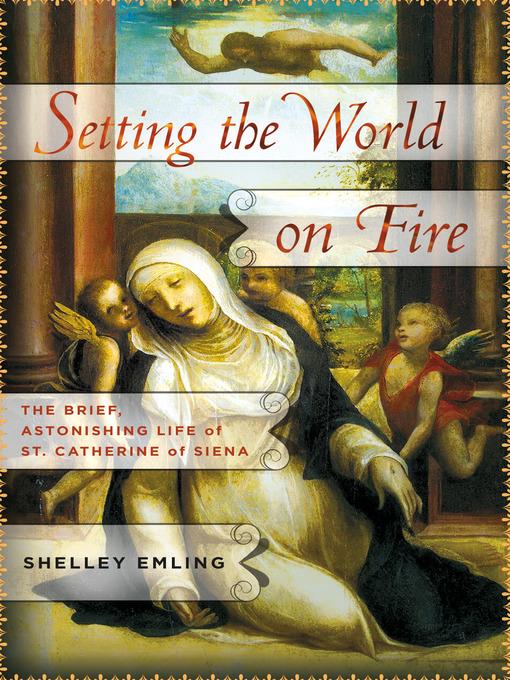
Setting the World on Fire
The Brief, Astonishing Life of St. Catherine of Siena
کتاب های مرتبط
- اطلاعات
- نقد و بررسی
- دیدگاه کاربران
نقد و بررسی

March 14, 2016
In this insightful biography, Huffington Post senior editor Emling (Marie Curie and Her Daughters) explores the humble powerhouse St. Catherine of Sienna. This daughter of a dyer, now one of two patron saints of Italy, was a study in contradictions. Though illiterate, she would become a respected writer. Though modest in appearance and frail, she was called on by kings, queens, and popes for guidance and for her influence among the people. Catherine's life in 14th-century Europe was filled with war and heavily influenced by the specter of the plague. Emling details Catherine's defiance of her parents' wish that she marry, her various mystical visions and experiences, her obsession with Christ's suffering and blood, her frankness with political and spiritual leaders who sought her out, and her campaign to unite Christians while calling for a holy crusade against Muslims. While at times the historical background can feel a bit long, Emling's portrait of St. Catherine's brief life and its tremendous influence in Italy and around the world is engaging and enlightening.

February 15, 2016
A biography of St. Catherine of Siena (1347-1380). Huffington Post senior editor Emling (Marie Curie and Her Daughters: The Private Lives of Science's First Family, 2012, etc.) offers an interesting and readable, though otherwise unremarkable, biography of St. Catherine, who entered the world in a time of violence, plague, and religious unrest. From her earliest years, Catherine showed an uncanny piety and devotion to her faith and to the established Catholic Church. She had her first vision of Christ at age 6, committed herself to a vow of virginity at age 7, and was regularly fasting soon after. Her life of 33 years would be marked by extreme self-denial--she often existed only on the Eucharist--and almost pathological desires for physical suffering and martyrdom. While barely in her 20s, Catherine jumped fully into the church politics of her day, encouraging the pope to vacate Avignon, France, and return to Rome and encouraging a crusade against Islam. Unfortunately, Emling does not confront the rather obvious question of how an uneducated woman in a thoroughly patriarchal world managed to address the political issues of her day and even win the admiration and devotion of popes and other leaders. Catherine managed to do the seemingly impossible in the course of only a few years, and yet the author presents her remarkable influence without asking how it occurred. Similarly, Emling's portrayal of Catherine is entirely uncritical, even to the point of being fawning. The author fails to pose obvious questions about Catherine's mental health and the veracity of contemporary sources. There is no doubt that general readers will find the book fascinating in many ways: Catherine lived a remarkable life and left an interesting story. However, Emling relies on the work of prior writers and offers little new in terms of either original research or unique approach. A worthwhile read, but expect nothing new on this saint.
COPYRIGHT(2016) Kirkus Reviews, ALL RIGHTS RESERVED.

March 1, 2016
As Emling (Marie Curie and Her Daughters) acknowledges, much of this book's content will seem bizarre, even disturbing, in the 21st century, when spirituality takes a very different form from the ostensibly masochistic practices of the Middle Ages. This first modern, secular biography of St. Catherine of Siena details the mystic's brief life from 1347-80, a time of "tragedy, violence, and corruption" in church and state. Catherine's reputation for holiness and wisdom led to her canonization in 1461; she was subsequently one of only four women to be named a doctor of the church. Outspoken on her convictions in an era when women kept silent, Catherine was not intimidated by the powerful and served as adviser to popes. Though illiterate, she composed "The Dialogue," a treatise on spiritual growth. Emling equates her with Thomas Aquinas as a theologian and central figure in the Catholic Church. The work also describes Catherine's personal life filled with extreme disciplinary practices including anorexia (characterized as "bordering on the psychotic"), self-flagellation, and a preoccupation with blood, which may be off-putting to some readers. VERDICT Aimed at a popular rather than scholarly audience, this work is of interest to traditional Catholics.--Denise J. Stankovics, Vernon, CT
Copyright 2016 Library Journal, LLC Used with permission.

























دیدگاه کاربران